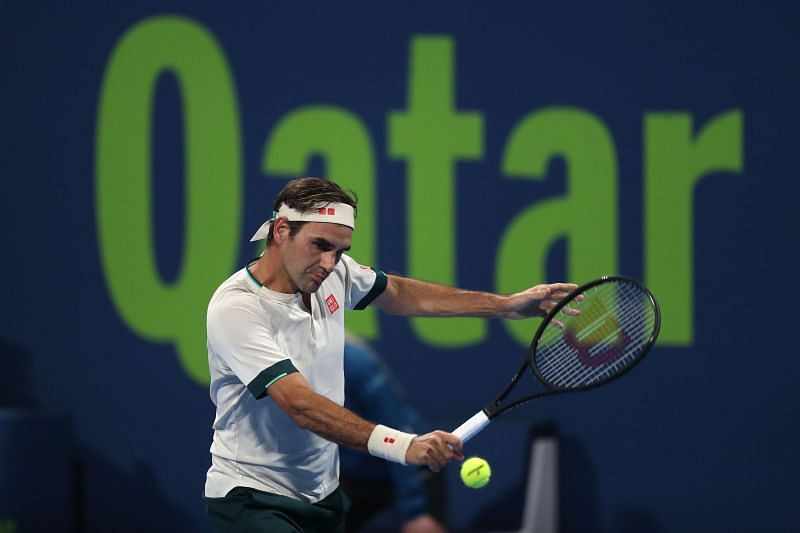
What did Roger Federer's comeback in Doha tell us about his level of play?
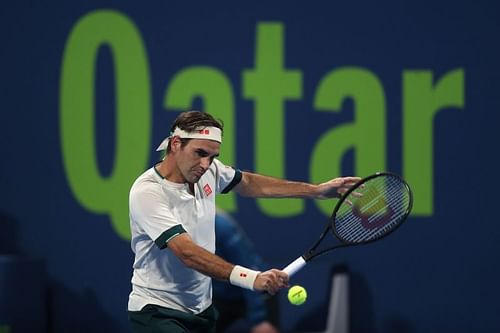
On the cusp of 40 years of age and after a little over a 400-day hiatus, Roger Federer returned to competitive tennis at the Qatar ExxonMobil in Doha earlier this week. And although his comeback was cut short by Nikoloz Basilashvili in the quarterfinals, the Swiss maestro gave his fans plenty of food for thought with respect to his post-surgery game.
Roger Federer started off against Dan Evans in the second round, and it would be fair to say that the pair weren't unfamiliar to each other.
Federer and Evans had squared off three times in official matches previously, each in a different Grand Slam. Besides that, when Federer returned from injury in 2017, it was Evans himself who he had faced in his first match, at the exhibition event that was the Hopman Cup.
The little familiarity that still remained a question was more than erased through the multiple practice sets they played against each other in their practice sessions at Doha.
But the man who is as household a name in tennis as anybody has ever been, was stepping into uncharted territory when he took the court for the second-round match. He had a mask on. And the stadium wasn't brimming with people.
For a moment it felt like Roger Federer had stepped into a new world, which was reinforced when he was heard asking the chair umpire at the coin toss how much time they had between points.
But when it came down to more practical matters, it was a different story altogether. When Mohammed Lahyani called out in his conspicuous Lahyani-esque voice, "Roger Federer to serve", and Federer served out wide to set up a +1 finisher, the world looked vintage. It was a visual of exactly what we had missed for a year.
The Swiss ended up losing to Basilashvili in the quarterfinals, but that match wasn't an indication of much given that Federer wasn't in the best shape for most of the second and third sets. The match against Evans, however, was a fascinating study of what Federer has changed in his game to accommodate his physical shortcomings, and what we can expect from him in the rest of his final phase.
Here's a detailed breakdown of everything that happened in those entertaining three sets between Roger Federer and Dan Evans:
Set 1
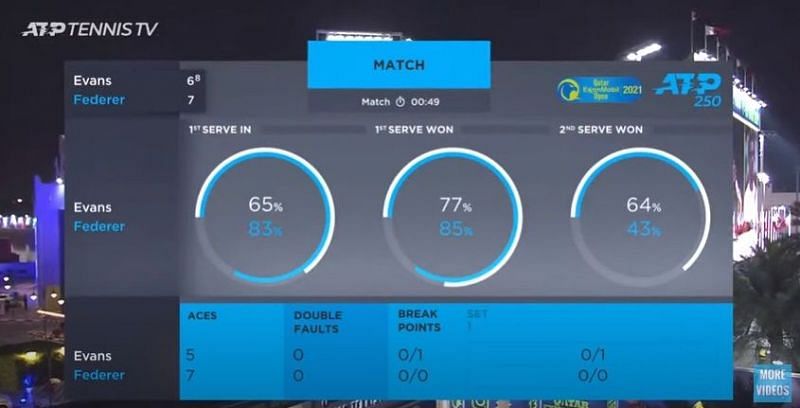
The story
For the best part of his declining years, the serve has arguably been the most reliable of Roger Federer's weapons. Even so, not many would have expected him to land 10 first serves in a row to inaugurate his comeback.
But that's exactly what happened. And on the 11th one, the first one that he missed, he hit an ace on his second delivery.
Roger Federer's comeback was looking pretty perfect as he both caressed and blasted winners from his end of the court. By the time we reached four games apiece, Federer had scored two love holds and Evans had played four more points on serve.
In the ninth game, Roger Federer again sent down two unreturnables to open up a 30-0 lead. He had landed 20 of 22 first serves up to this point. But then, all of a sudden, his percentage fell off.
Dan Evans capitalized, drawing him into a 10-shot rally and putting away an inside-out forehand winner. That was followed by a backhand down-the-line winner, and out of nowhere, it was Evans who had reached break point for the first time in the match.
With his first serve still on vacation, Roger Federer called upon a forehand to bail him out of trouble - which it did. Then while serving to stay in the set, Evans sent down two aces of his own and held.
They traded two more comfortable holds, to take the set into a tiebreaker.
Dan Evans made a cheap backhand error on his serve+1 shot to hand Roger Federer an early mini-break, going down 0-2. But with two unreturned serves, which sandwiched two perfect passes on Federer's serve, it was Evans who took the lead 4-2 as they changed ends.
Roger Federer returned the favor with a backhand pass of his own, followed by a forehand winner and then an ace. You could sense the match lifting off. With both players being old-school practitioners of all-court play, winners of all kinds were flying all over the court: serves, groundstrokes, volleys and passing shots.
Dan Evans reached set point first, but it was on Roger Federer's serve. After saving it with aplomb, Federer produced a brilliant crosscourt forehand on the stretch to set up set point on his own serve.
The Swiss then produced perhaps his most mortal moment of the match, as he completely misjudged and misplayed a forehand drive volley; the ball landed closer to his own shoes than to the other side of the net. But he shook it off with a smile, and a magical backhand pass later, Roger Federer had won his first set in 14 months - 10 points to 8 in the breaker.
The numbers


Roger Federer served mostly wide, on both sides of the court, although not with a great disparity. Dan Evans on the other hand primarily aimed at not providing the Swiss room on the forehand side, with a few occasional change-ups.
Federer perhaps feels slightly more confident in his serve+1 game when he opens up the court - as suggested by the fact that he served nine of his first 10 serves of the match out wide. More significantly, when he had that tough service game at 4-4, he kept serving wide on the big points.
Meanwhile Evans, with visibly less precision on his serve, resorted to jamming Federer close to his body. And it almost paid off for him.
Roger Federer recorded a non-negative winner-error ratio on all his strokes, and his serve stood out in particular with a +7 differential. Dan Evans, while he was using his backhand very efficiently to defend and vary the spins, went -3 on that wing. And perhaps that little difference is what cost him the set.
Set 2
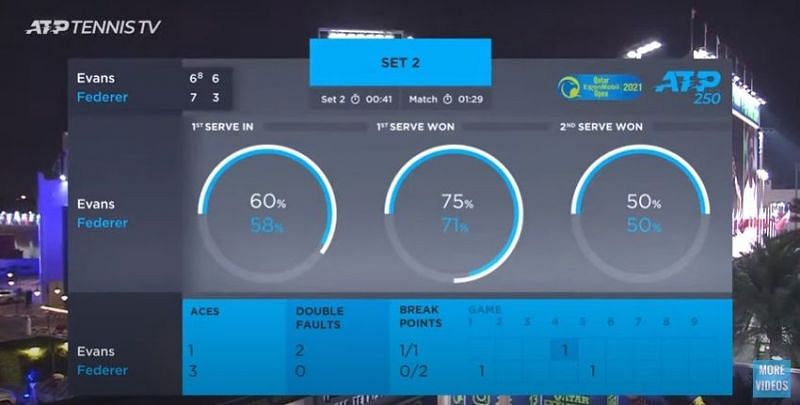
The story
The adrenaline had settled down. Roger Federer knew the importance of the first set, especially when it went to the tiebreak. So did Dan Evans. And so did any experienced observer of the game.
Experience would also, naturally, make us believe in Federer being the firm favorite by that point. After all, Evans had never taken a set off the Swiss until then, while the latter had won 10.
You'd have only gained more confidence in your experience after watching the first game of the second set. Roger Federer unleashed a barrage of winners from 40-0 down to reach his first break point of the match. But a volley winner and a couple of volley errors later, Evans was safe.
We all know Federer's eternally volatile relationship with break points. But he didn't let that early missed opportunity get the better of him as he held his own serve comfortably and again challenged the Evans serve, albeit unsuccessfully.
But similar to the previous set, Roger Federer found himself in trouble on serve against the run of play - this time at 1-2. In a game that started with Federer slice-lobbing Evans for one of his several hotshots of the match, the Swiss ended up being dragged in one too many long exchanges.
From 40-30, Federer committed three unforced errors, each in 8+ shot rallies, to hand Evans the first break of the match.
In the previous nine sets they had played, Roger Federer had broken Dan Evans 19 times off 34 break points, while Evans had scored merely three out of eight. But this wasn't just another day at the office for the Brit. Serving ahead at 3-1, with the wind firmly at his back (literally), Evans looked to take flight.
Roger Federer wasn't going to let him off the hook easily though. The Swiss set up another break point as his forehand skidded off Evans' baseline, causing the latter to shank. But again, another forehand error allowed Evans to dig himself out of the hole.
The pattern played out to perfection in Evans' favor until he served for the set at 5-3. No, Federer didn't break in the ninth game; rather, the difference lay in the fact that it was the only game of the set where Evans held easily.
The Brit changed up his service direction and went to Federer's forehand in the first two points of the game, both unreturned, to open up a 30-0 lead. He won the next two points as well for his first love hold of the match, the second set, and of course, his first set over Roger Federer.
The numbers


There was little that could be guessed on the Roger Federer serve, as has been the norm since ages, while Dan Evans stuck firm to his pattern despite the loss of the first set. Interestingly, however, Evans didn't make a single unforced error in Federer's service games.
Even on his own serve, when he theoretically takes control through the first shot of the rally, Evans gave away a measly four unforced errors. In comparison, Federer's unforced error count rose to six more on his opponent's serve than that of his own.
This can be attributed to both the greater number of points played on the Evans serve (40 as opposed to 24) and the increased rally length (5.3 shots), given that Federer was the one crumbling more often in the extended points.
Roger Federer ended up with a -3 differential on his forehand and a -8 differential on his backhand in the second set. Dan Evans, meanwhile, stayed non-negative if we overlook his two double faults.
Set 3
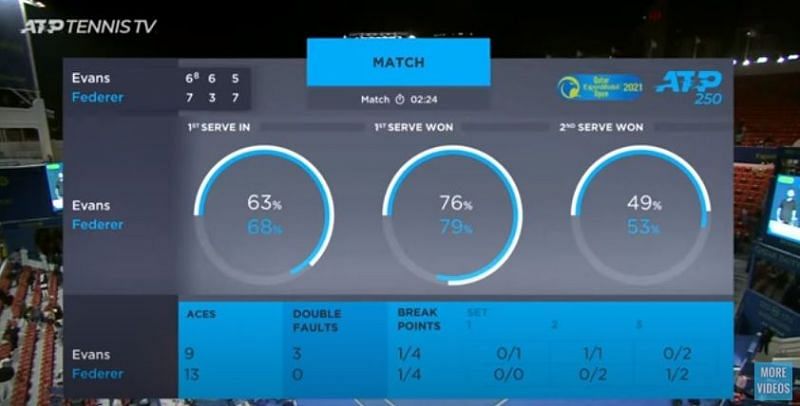
The story
Is this how the comeback was supposed to go? Sure he had scripted a fairytale four years ago, but this was the second round of a 250 tournament.
On paper, it doesn't look that precious. On paper, it doesn't look so tough either. But as the adage goes, sports isn't played on paper.
A rejuvenated Dan Evans struck an oil-painting of a backhand to open the deciding set with a 0-15 lead on the Roger Federer serve, sending shivers down the spines of Federer fans. But that didn't end up being the theme of the decider. Instead, it was Federer who kept making an honest effort at being even more aggressive.
This wasn't aggression in terms of raw power though. Roger Federer had looked rather uncomfortable at the net up until this point, at least by his standards. While most would have predicted his groundstrokes to trouble him more in his comeback match, it was surprisingly his net game that was raising most eyebrows.
Yes, everybody is entitled to miss a volley here and there. But Roger Federer's decision-making had seemed off for the greater part of the night. Besides making uncharacteristic approaches, he also seemed to have acquired a divine ability of hitting volleys straight back to the small target that is Dan Evans - rather than to the open court.
Not many players stick to their instincts the way Roger Federer does. But to the casual observer, his relentless forward aggression seemed more forced than by being spoiled for choice.
Evans looked the fresher of the two. Federer's footwork looked lethargic. And lengthy groundstroke affairs paved the way for robust net forays.
The first long-drawn game of the final set came at 3-2, on the Evans serve as expected. The Brit made just two of his six first serves to get pegged to deuce. However, first serves helped him claw out of danger.
In the very next game, it was Roger Federer's turn to face the heat. With the score evenly poised at 3-3, Evans had a break point and Federer had a second serve. But the maestro pulled off his first drop shot winner of the match to save it.
How hard did they push each other in their practice sets? They were more than thoroughly testing each other out there on the match court.
Serving to stay in the match at 4-5, Dan Evans faced his first match point. Unfazed, he followed up a serve out wide by charging to the net and putting away a backhand volley.
On the opening point of the next Federer service game, Evans danced up the court following his return of serve. But the Swiss, seemingly caught in no man's land, produced a backhand drive volley passing winner off his showlaces.
Federer held, and with the advantage of serving first in the decider, a tiebreaker was the worst that could happen to him.
Dan Evans had earlier produced his best service game to close out the second set. However, he faltered when it came to saving the third.
The Brit opened that 5-6 game with a double fault. And Federer eventually closed out the match with a backhand winner down the line.
The numbers


Roger Federer employed a few body serves in this set on the deuce court, while Dan Evans stayed true to his earlier pattern. The average rally length on the Federer serve was higher than that in the other sets. But that was largely because of him not missing as much as in the second, and not serving as well as in the first.
The Swiss made 19 trips to the net, which was greater than what he did in the first two sets combined. More importantly, he won 14 of those points.
Evans also had more net points in this set, as a large chunk of the action was dominated by proactive tennis.
Roger Federer produced a +9 differential on his volleys in the deciding set, which ultimately won him the match. Interestingly, in this set, Federer had a 0 differential on his forehand and a +1 differential on his backhand. Often his greatest liability, his backhand stood up to the test when it mattered the most.
Evans didn't do much wrong either. He just lost out in an arm-wrestle.
The aftermath
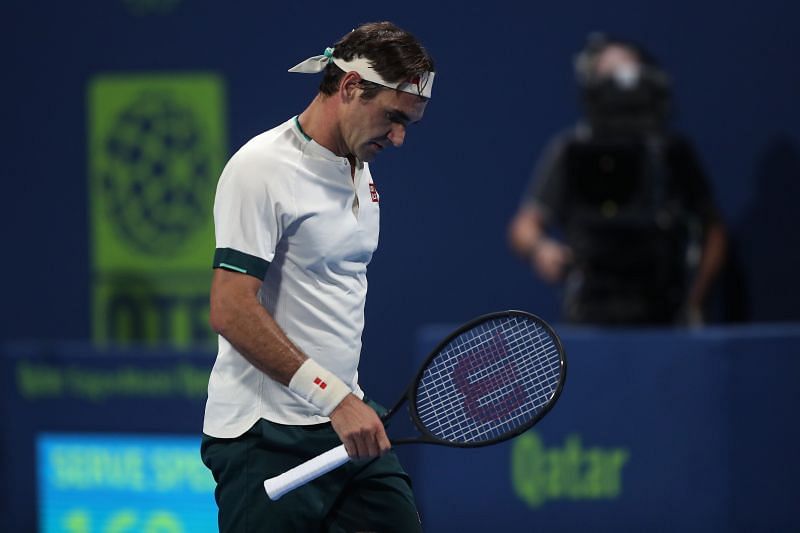
This was a match for the romantics; it had drama for its lovers and thrill for its seekers. But as good as it was, Roger Federer went on to lose his next match to Nikoloz Basilashvili.
Where does he go from from here? The optimist would be delighted to see the highlight reel he is still capable of producing. The pessimist would fret over his physical struggles. But how can the fan not celebrate his return? And his serve? And everything else about him?
From the technical standpoint, the key takeaway is that Roger Federer's groundstrokes are as good as they've been over the last couple of years. The volleys seem to be a work in progress, but his commitment to bounding forward remains as unshakable as ever. And most importantly, the serve has lost none of its sting.
But at this stage of Roger Federer's career, the technicalities are just one part of the story. His energy levels are a big question mark, especially in light of the way he faded against Basilashvili. The Swiss has pulled out of Dubai too in order to work on his fitness, and his fans would be hoping that there is some improvement in that regard the next time he takes the court.